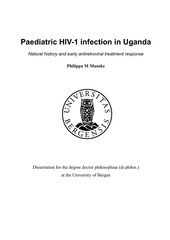Paediatric HIV-1 infection in Uganda. Natural history and early antiretroviral treatment response
Doctoral thesis
Permanent lenke
https://hdl.handle.net/1956/5168Utgivelsesdato
2011-10-07Metadata
Vis full innførselSamlinger
Sammendrag
Paediatric HIV-1 infection remains a major problem for sub-Saharan Africa with over 1300 new infections daily. Infected children have a high mortality with 50% dying by 2 years of age. Access to antiretroviral therapy (ART) has significantly reduced the morbidity and mortality rates, however, appropriate monitoring of response to treatment remains a challenge. Objectives The studies included in this thesis were designed to: 1) describe the natural history of a cohort of HIV infected Ugandan children; 2) determine if the Total Lymphocyte Count (TLC) could be used as a surrogate marker for death in infected children; 3) document the growth, immune and virological response to antiretroviral therapy; and to: 4) document the antiretroviral treatment outcome of children exposed and not exposed to single dose nevirapine (sdNVP) at birth. Methods Cohort 1 (n=128) included infected children from the perinatal HIV prevention trial (HIVNET012) who were followed from birth to 5 years of age. History and physical examinations were conducted at birth, 6, 10 and 14 weeks, at 6, 12 and 18 months and every following 6 months. CD4% and HIV-1 RNA were measured at birth, 14 weeks, 12 months, and every 6 months thereafter (Papers I & II). Cohort 2 (n= 124) included HIV-1 infected children who were initiated on ART and followed for a minimum of 48 weeks. CD4% and HIV-1 RNA were measured at baseline and 12, 24, 36 and 48 weeks after starting ART (Paper III). Children were classified into virological (V) and immunological (I) treatment success(S) or failure (F) (Paper III). A subset of children (n=92) exposed to NVP (at birth) at a median of 1.7 years prior to ART and not exposed to NVP were initiated on NVP-based ART regimen and followed for 48 weeks (Paper IV). The data was analyzed to determine factors associated with survival and treatment outcome. Results The infected children had a very high mortality rate with 56/128 (42%) and 70/128 (55%) dying by 2 and 5 years of age, respectively. Time to death was not statistically different for those infected in utero compared to those infected later when estimated from time of HIV acquisition. The leading causes of death were pneumonia, diarrhoea and malaria, similar to the uninfected children. There was a rapid decline in CD4% in the first 6 months of life and then a plateau but the HIV-1 RNA levels remained high (5.5 log10) throughout the 5 year follow-up (Paper I). The TLC did not correlate with the CD4 cell count (r = 0.01) or predict death in the next 12 months, when the WHO TLC thresholds were used (Paper II). Over 85 % (107/ 124) of the children who initiated ART had an undetectable viral load after 48 weeks of therapy. Those who initiated ART below 3 years of age had a greater increase in weight and height and those children with CD4 % > 15% at ART initiation were more likely to achieve treatment success(Paper III). Baseline CD4 %, age and WHO stage were the baseline factors associated with successful treatment outcome (Paper III). In the substudy (n=92), after 48 weeks on ART, 75% (33 /44) and 78% (35/44) of the children exposed and not exposed to sdNVP had an undetectable viral load (< 400 copies/ml), respectively (p=0.8, Paper IV). Conclusion From the studies included in this thesis, we established that HIV infected Ugandan children had a very high mortality rate in the first 2 years of life, regardless of time of HIV acquisition. The TLC was not an appropriate surrogate marker for death and therefore could not be used to determine which children needed ART. Early initiation of ART was critical to ensure adequate growth and ARV treatment success. Older children exposed to sdNVP at birth benefited from a NVP based regimen and should not be denied access to ART when protease inhibitors (PI) are unavailable.
Består av
Paper I: Musoke PM, Mwatha T, Brown E, Bagenda D, Owor M, Lubega IR, Ndugwa CM, Fowler MG, Jackson JB, Guay LA. Natural history of HIV infection in perinatally infected Ugandan children from birth to five years: the HIVNET012 cohort. Full text not available in BORA.Paper II: Musoke PM, Young AM, Owor MA, Lubega IR, Brown ER, Mmiro FA, Mofenson LM, Jackson JB, Fowler MG, Guay LA.Total lymphocyte count: not a surrogate marker for risk of death in HIV infected Ugandan children. JAIDS 2008;49:171-8 Full text not available in BORA due to publisher restrictions. The article is available at: http://dx.doi.org/10.1097/QAI.0b013e318183a92a
Paper III: Musoke PM, Mudiope P, Barlow-Mosha LN, Ajuna P, Bagenda D, Mubiru MM, Tylleskar T, Fowler MG.Growth, immune and viral responses in HIV infected Ugandan children receiving highly active antiretroviral therapy: a prospective cohort study. BMC Pediatrics 2010;10:56. The article is available at: http://hdl.handle.net/1956/5167
Paper IV: Musoke PM, Barlow-Mosha L, Bagenda D, Mudiope P, Mubiru M, Ajuna P, Tumwine JK, Fowler MG. Response to antiretroviral therapy in HIV infected Ugandan children exposed and not exposed to single dose Nevirapine at birth. JAIDS 2009;52:560-8. Full text not available in BORA due to publisher restrictions. The article is available at: http://dx.doi.org/0.1097/QAI.0b013e3181b93a5a
